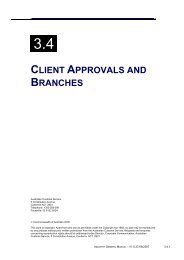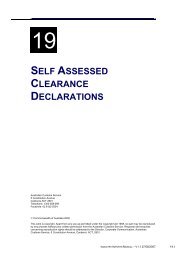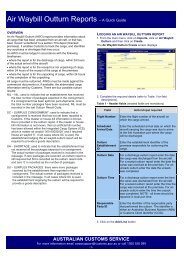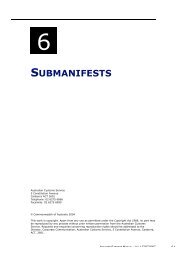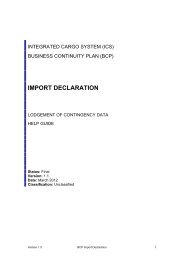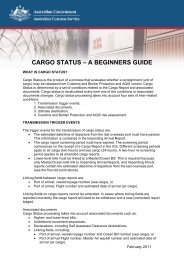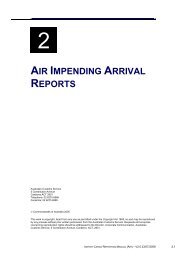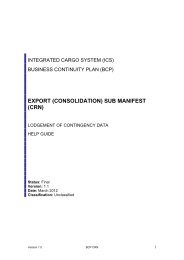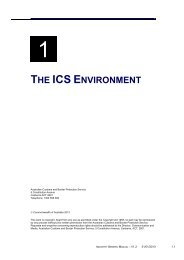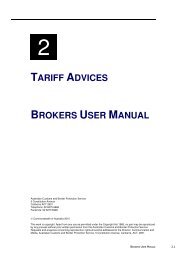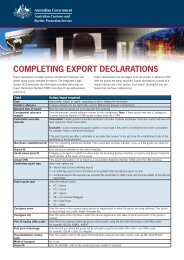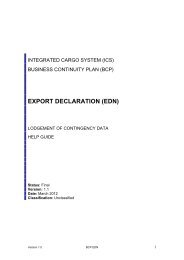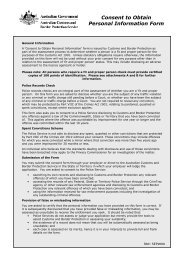EXPORT DECLARATION - Australian Customs Service
EXPORT DECLARATION - Australian Customs Service
EXPORT DECLARATION - Australian Customs Service
You also want an ePaper? Increase the reach of your titles
YUMPU automatically turns print PDFs into web optimized ePapers that Google loves.
1. <strong>Customs</strong> File Reference<br />
<strong>Customs</strong> Use. Leave Blank.<br />
2. Reporting Party Type (mandatory)<br />
Tick either the Owner or Agent box to identify the Reporting Party<br />
Type.<br />
3. Your Reference (mandatory)<br />
This reference must be unique and be used for both your files and<br />
to differentiate between consignments.<br />
4. Reporting Party ID (mandatory)<br />
The <strong>Customs</strong> identifier of the party lodging the declaration.<br />
The identifier must be either an <strong>Australian</strong> Business Number (ABN)<br />
or <strong>Customs</strong> Client Identifier (CCID).<br />
5. Intended date of Export (mandatory)<br />
Expressed as DD/MM/YYYY.<br />
6. Unique Consignment Reference No. (Optional)<br />
For use as an alternative release process, where a Contingency<br />
<strong>Customs</strong> Authority Number (C-CAN) is quoted to <strong>Customs</strong> and<br />
Border Protection.<br />
7. Customable/Excisable Indicator (mandatory)<br />
Show whether or not the goods would be subject to <strong>Customs</strong> and<br />
Border Protection Excise duty if they were to be delivered into<br />
home consumption rather than being exported.<br />
Tick Y for ‘Yes’<br />
Tick N for ‘No’<br />
8. Prescribed Goods Indicator (mandatory)<br />
The code indicating whether or not goods covered by the declaration<br />
are prescribed goods under section 102A of the <strong>Customs</strong> Act 1901<br />
(the Act):<br />
Tick Y for ‘Yes’<br />
Tick N for ‘No’<br />
9. Warehouse Establishment ID (mandatory if Customable /<br />
Excisable Indicator is Yes)<br />
Establishment code of the warehouse or excise place from which<br />
the goods are to be removed.<br />
10. Goods Owner Party ID (mandatory)<br />
The <strong>Customs</strong> Owner Party ID of the common law owner of the<br />
goods. This must be either an <strong>Australian</strong> Business Number (ABN)<br />
or a <strong>Customs</strong> Client Identifier (CCID). If Reporting Party Type<br />
is ‘Agent’, the ABN or CCID for this item cannot be the same as<br />
Reporting Party ID.<br />
11. Branch ID<br />
An identifier that is linked to the Goods Owner Party ID, used to<br />
further identify the party within that organisation.<br />
12. Confirming Exporter Type (mandatory)<br />
A code indicating whether the exporter has confirming export<br />
status and proposes to rely on that status in relation to goods in<br />
the declaration.<br />
Confirming: Y<br />
Non Confirming: N<br />
Confirmed: C<br />
13. Export Goods Type (mandatory)<br />
Please tick the appropriate box.<br />
Stores: ST<br />
Postal: PO<br />
Spares: SP<br />
Accompanied Baggage: AB<br />
Own Power: OP<br />
Other: OT<br />
14. Consignee Name (mandatory)<br />
The name of the person/organisation taking physical possession<br />
of the goods. This should be the principal, not a bank, freight<br />
forwarder, etc.<br />
15. Consignee City (mandatory)<br />
The city/town in which the person/organisation who takes final<br />
physical possession of the goods is located<br />
16. Port of Loading (mandatory)<br />
The port in Australia where the goods are loaded on board a vessel<br />
to begin their international voyage.<br />
17. First Port of Discharge (mandatory)<br />
The name of the first port of discharge overseas.<br />
18. Final Destination Country Code (mandatory)<br />
The name of the country that is to be the final destination of the<br />
goods.<br />
19. Mode of Transport (mandatory unless Export Goods Type is<br />
PO, then leave blank)<br />
Tick the appropriate box<br />
20. Vessel ID/Flight No (mandatory if Export Goods is ‘ST’, ‘SP’ or<br />
‘AB’)<br />
The Lloyd’s identity number, registration number of the aircraft, or<br />
<strong>Customs</strong> identifier.<br />
Notes for Completing an Export Declaration<br />
21. Voyage No (mandatory if Vessel Id/Flight No. requires a Vessel<br />
ID) A unique voyage number of the vessel carrying the goods.<br />
22. Cargo Type<br />
Please tick the appropriate box.<br />
Containerised: C<br />
Co-Combination: CO<br />
Non-Containerised: N<br />
Bulk: B<br />
23. Total No Packages (mandatory if Mode of Transport is air or if<br />
Mode of Transport is sea and Cargo Type is ‘N’ or ‘CO’)<br />
24. Total No Containers (mandatory if Mode of Transport is ‘S’<br />
and Cargo Type is ‘C’ or ‘CO”)<br />
“Containers” refers to the Sea Cargo Containers.<br />
25. Invoice Currency (mandatory)<br />
26. FOB Currency (mandatory)<br />
i/e. <strong>Australian</strong> dollars, etc.<br />
27. Total FOB Value (mandatory)<br />
The total free on board (FOB) value of the goods, including all<br />
costs incidental to the sale and delivery of the goods on to the<br />
exporting vessel/aircraft. No discount given is to be deducted from<br />
the true value of the goods. The FOB value should be expressed<br />
to the nearest dollar. It should be noted that FOB does not include<br />
overseas freight and insurance. The FOB values of samples must<br />
be shown as the market value of the goods as if they were for<br />
sale.<br />
28A. Line No (mandatory)<br />
A supplementary page must be completed for each separate<br />
commodity as identified by the AHECC code (see Commodity<br />
Classification). If the goods to be exported are minerals requiring<br />
an assay, use the B957a supplementary page.<br />
28. Commodity Classification (mandatory)<br />
<strong>Australian</strong> Harmonized Export Commodity Classification (AHECC)<br />
code is statistical classification for the particular commodity being<br />
exported. This code may be obtained from <strong>Customs</strong> and Border<br />
Protection.<br />
29. Goods Description (mandatory)<br />
A description of the goods.<br />
30. Goods Origin Code (mandatory)<br />
The code used to identify the <strong>Australian</strong> (or foreign) state of origin<br />
of goods, as listed below:<br />
NSW: AU-NS<br />
TAS: AU – TS<br />
VIC: AU-VI<br />
NT: AU-NT<br />
QLD: AU-QL<br />
ACT: AU-CT<br />
SA: AU-SA<br />
WA: AU-WA<br />
FOREIGN: YY-FO<br />
31. Goods Origin Country Code (mandatory if Goods Origin<br />
Code is “Foreign”)<br />
The name of the primary country where the goods were<br />
manufactured or produced.<br />
32. Temporary Import No (mandatory if the AHECC is for the<br />
export of goods originally imported on a temporary basis)<br />
A number identifying the export of goods which are temporarily<br />
imported under section 162 or 162A of the <strong>Customs</strong> Act 1901.<br />
33. Net Quantity (mandatory)<br />
The net quantity of goods is described in terms of the units<br />
prescribed in the AHECC, (e.g. KG, T, NO). If the unit prescribed<br />
by the AHECC is ‘NR’, the quantity details are not required, but NR<br />
must be shown in the units box. Net quantity should not include<br />
the weight of any additional packaging.<br />
34. Gross Weight (mandatory)<br />
The gross weight is, in effect, the shipping weight of the goods. It<br />
should include the weight of any immediate packaging but not the<br />
weight of the container. Show weight in grams (G), Kilograms (KG)<br />
or tonnes (T).<br />
35. Line FOB Value<br />
The FOB value of the goods quoted on this export declaration line,<br />
(see Item 25). The FOB value should be expressed to the nearest<br />
dollar. (Also see Line FOB Value of the B957a supplementary<br />
page).<br />
36. Permit Details (prefix/Permit No)<br />
A wide range of goods are prohibited from exportation unless an<br />
export permit is obtained from the appropriate agency. Details of<br />
export restrictions are contained in various Commonwealth laws.<br />
Further advice can be obtained from your legal adviser, agent,<br />
etc, or <strong>Customs</strong> and Border Protection. Input the permit number<br />
given by the relevant permit issuing authority. Each permit issuing<br />
authority has its own permit prefix. The correct prefix must be<br />
included for all permits.<br />
B957 (APR 2010)



